High Flux Beam Reactor Interim Stabilization and Cleanup Actions
Since the High Flux Beam Reactor (HFBR) was shut down in 1997 and permanently closed in 1999, many actions have been taken to partially decommission and prepare the HFBR for safe storage. Final decommissioning of the HFBR building will be performed at the completion of the decay period. The actions undertaken throughout the HFBR complex ensure that it remains in a safe and stable condition and prepared it for long-term surveillance and maintenance and decommissioning.
Regulatory Requirements
The stabilization and partial decommissioning of the HFBR was conducted under the federal Comprehensive Environmental Response, Compensation, and Liability Act (CERCLA). In 1992, an Interagency Agreement (PDF) among the DOE, the U.S. Environmental Protection Agency (EPA) and the New York State Department of Environmental Conservation (NYSDEC) became effective. The IAG provided the overall framework for conducting environmental restoration activities at BNL.
Record Of Decision
The selected remedial alternative is documented in the HFBR Record of Decision (PDF) which was approved by the DOE and EPA with the concurrence of the NYSDEC, the New York State Department of Health (NYSDOH), and the Suffolk County Department of Health Services (SCDHS) in February, 2009. The selected remedy included phased Decontamination and Dismantlement (D&D) with near-term control rod blade removal.
The final remedy for the HFBR incorporated many cleanup actions, including: removal and disposal of HFBR fuel and primary coolant; shipment of equipment for reuse at other facilities; cleanup and transfer of the Cold Neutron Facility for reuse; dismantling of many ancillary buildings in the HFBR complex; cleanup of the Waste Loading Area; removal of contaminated underground utilities and piping; removal and disposal of the reactor control rod blades and beam plugs; and preparation of the confinement building for safe storage. The remedy also includes a number of near-term actions to be completed by 2020, including dismantling of the HFBR Stack and associated components.
The segmentation, removal, and disposal of the remaining HFBR structures, systems and components (reactor vessel, thermal shield, biological shield, and others) after a safe storage decay period (not to exceed 65 years) are also part of the final remedy. The decay period allows for the natural reduction of the high radiation dose rates to a point where conventional demolition techniques can be used for the dismantling of the large activated components.
Cleanup Actions
The actions undertaken to stabilize and secure the HFBR included removing contaminated structures, hazardous materials, and radioactively contaminated equipment and components to deactivate and stabilize the facility in preparation for decommissioning and dismantling. The actions taken included:
- All spent fuel was shipped to an off-site facility (1998).
- The cooling tower superstructure was dismantled and disposed of as waste (1999).
- More than 10,900 gallons of tritiated heavy water, the primary coolant for the reactor, was removed (2001).
- Shielding blocks and chemicals were removed and are being reused at the Laboratory and at other facilities (2000 - 2005).
- Scientific equipment was removed and is being reused or has been sent to an off-site disposal facility (2003).
- The confinement structure and spent fuel pool were modified to meet the requirements of Article 12 of the Suffolk County Sanitary Code. Article 12 regulates toxic and hazardous materials storage and handling. (2004)
- The Cold Neutron Facility was decontaminated and cleaned for reuse (2006).
- The cooling tower basin, the guard house, the electrical/pump house, the water treatment house, and the stack monitoring facility were dismantled and removed (2006).
- The HFBR control rod blades and beam plugs were removed (2009).
- The waste transfer lines were removed (2009).
- The HFBR confinement is placed in long-term safe storage (2010).
- The HFBR underground utilities were excavated and removed (2010).
- The Building 704 Fan House was dismantled and removed (2010).
- The Building 802 Fan House was dismantled and removed (2011).
- The HFBR stack silencer baffles were removed (2011).
Cleanup Photos
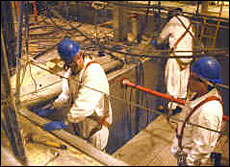 Installation of spent fuel pool canal liner
Installation of spent fuel pool canal liner
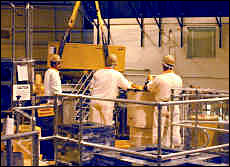 Removal of contaminated lead
Removal of contaminated lead
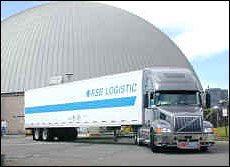 Shipping of heavy water offsite
Shipping of heavy water offsite
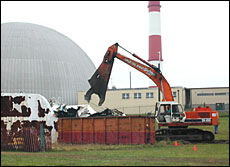 Demolition of the cooling water hold-up tank
Demolition of the cooling water hold-up tank
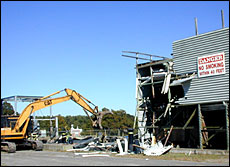 Demolition of the cooling towers
Demolition of the cooling towers
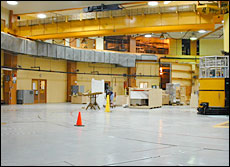 Inside the HFBR: experimental floor cleared of equipment
Inside the HFBR: experimental floor cleared of equipment
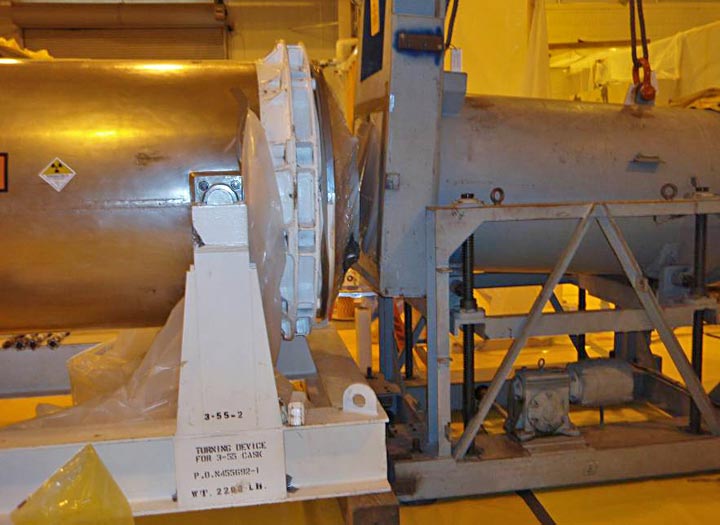
Transfer of a beam plug into the shipping cask
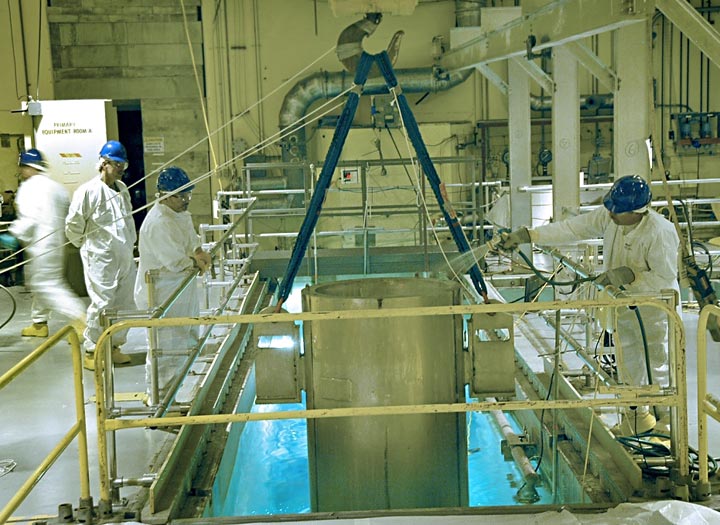 A control rod blade shipping cask being lowered into the fuel pool
A control rod blade shipping cask being lowered into the fuel pool
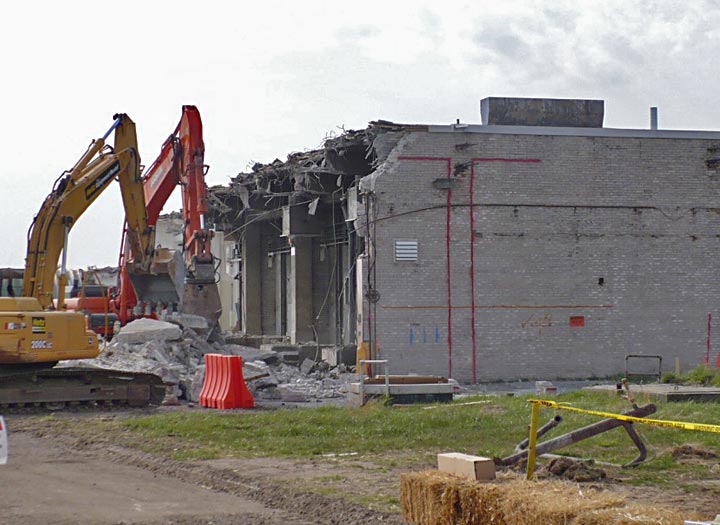 Demolition of the southern half of Building 704
Demolition of the southern half of Building 704
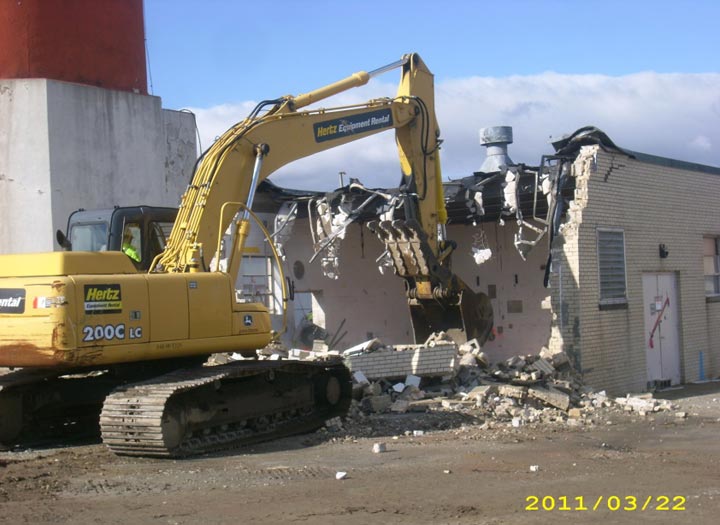 Demolition of Building 802
Demolition of Building 802
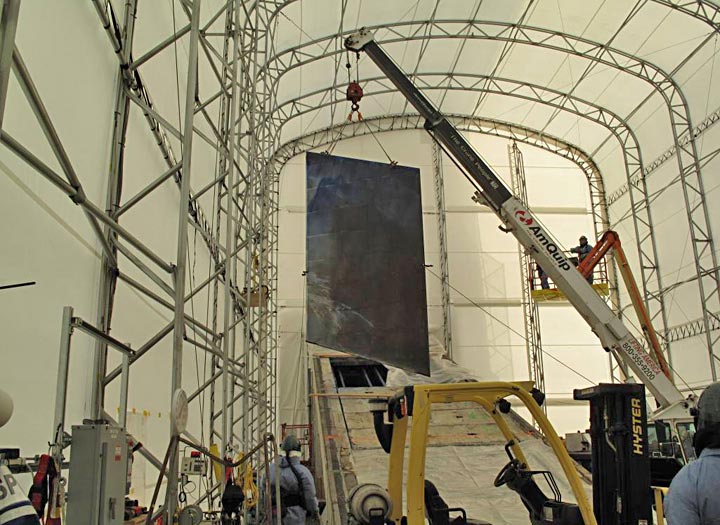 Baffle removed from Stack Silencer
Baffle removed from Stack Silencer
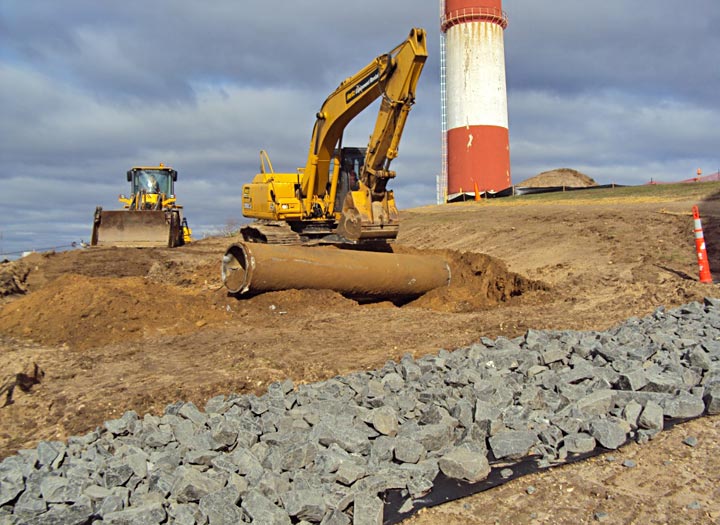 Removal of 30-inch duct during underground utilities removal
Removal of 30-inch duct during underground utilities removal
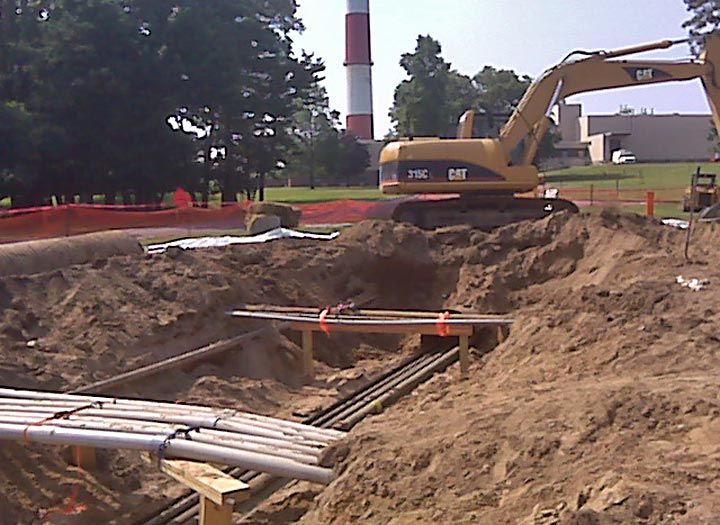 Exposed waste transfer lines beneath braced active underground utilities
Exposed waste transfer lines beneath braced active underground utilities
Groundwater Cleanup and Monitoring
Extensive groundwater characterization was conducted between 1997 and 1999 to determine the extent of the tritium contamination. The leak was confined to Lab property and both the U.S. EPA and SCDHS agreed that it posed no threat to BNL employees or to public health, nor did it affect any drinking water supplies.
The pump-and-recharge system was installed in 1997 and operated until 2000. Installed near the southern edge of the 2,200 foot-long plume, the system was designed to remove the groundwater containing tritium from the aquifer and pump it to a recharge basin further north. There, the water was allowed to re-enter the aquifer. Groundwater monitoring showed that this system was effective in halting the southward migration of the tritium plume at a point approximately 3,500 feet north of the site boundary. It ensured that any tritium in the groundwater would be below drinking water standards before it reached the Lab boundary. The system was turned off in September 2000 and placed in stand-by mode since groundwater data indicated that the plume was not growing.
Additional groundwater remediation was conducted at the HFBR in 2000 and 2001, when a low-flow pumping system extracted the highest levels of tritium from the groundwater near the reactor. A total of approximately 90,000 gallons of water were removed from the aquifer and disposed of off the Lab site.
Monitoring of the HFBR groundwater contamination has continued in accordance with the Operable Unit III Record of Decision (PDF) which details the selected remedial actions for areas of groundwater contamination at BNL. In November 2006, groundwater triggers for tritium were reached and it was recommended that the pump-and-recharge system be restarted and an additional extraction well was installed in 2007.
The current status of the groundwater contamination is discusses in the annual Groundwater Status Reports.


